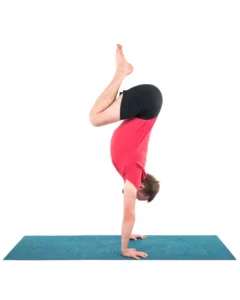Want to Feel Better? Just Breathe – The Power of Bhramari Pranayama (Humming Bee’s Breath)

Want to learn a simple trick to feel better? Just breathe. But not just any type of breathing. Learn how the yogic practice of Bhramari Pranayama (Humming Bee’s Breath) can help shift your nervous system into parasympathetic functioning, the Rest and Digest part of our nervous system’s balancing program.
One little known fact about yogic breathing techniques concerns their profound effects on the autonomic nervous system. Extending or lengthening the exhalation is a powerful way to trigger the parasympathetic nervous system, the Rest and Digest part of our nervous system’s balancing program. In fact, our breath patterns affect the nervous system in both ways – to either balance and quiet the system or excite it. It’s worhwhile to understand how this actually happens.
How Does Your Breath Affect Your Nervous System?
The Autonomic Nervous System (ANS) that connects brain to body is a two-way street. If I am anxious and nervous or stressed out by events in my life or simply the thoughts about those events, my brain, via the nerves of the ANS, will likely turn on the Sympathetic part of that system (the Fight or Flight response), which could result in faster heart and breathing rates, and increases in blood pressure, to mention just two of the most obvious physiological changes.
But the cool thing is that the lungs and heart can feed back to the brain and essentially convince the brain that things are calm and peaceful, even when there are still stressful circumstances. One neat way this happens involves the relationship of the heart and lungs and the nerves between them.
In each round of breath, during your inhalation, your heart gets stimulated to beat a little faster. Then during the exhalation that follows, your heart gets told to slow down a tad. The overall effect is very little change in the heart rate from minute to minute.
How NOT To Deepen Your Breath
When you make one part of the breath cycle, either the inhale or the exhale, longer than the other, and you do this for several minutes, the accumulated effect is that you will either slow the heart rate down or speed it up from where you started.
The standard instruction to get people to breath more deeply to induce relaxation is “to take a deep breath.” However, when you make the inhales longer than the exhales, for example, by using a two-second inhale and a one-second exhale, and you keep this up for several minutes, it will have the opposite effect of what you are trying to accomplish.
The heart rate will go a bit faster. This will send a feedback message to the brain that things need to activate more in the brain and body for whatever work there is to be done, stimulating the Sympathetic portion of the ANS.
Enter Bhramari Pranayama (Humming Bee’s Breath) – A Simple Technique for Greater Calm and Well-being
With the very useful Bhramari breath (Bee’s Breath), we do the opposite. As we hum during the exhalation, the exhales get longer relative to the inhales, as when we do a 1:2 ratio breath practice without the humming.
This new respiratory cycle begins to slow down the heart rate, sending a message to the brain that everything is more peaceful and calm than five minutes ago, allowing the brain to support this shift further by activating the Parasympathetic portion of the ANS (the Rest and Digest or Relaxation response) that goes back from brain to body.
Research has shown that the vagus nerve as well as certain chemical neurotransmitters account for these effects of breath patterns on heart rate and subsequently on shifting the balance between the Sympathetic and Parasympathetic parts of the ANS. Keep in mind that the ANS is trying to keep all background systems in balance and responding appropriately to ever-changing circumstances of our day.
In short, our conscious choice of breathing differently can shift us to a more desirable part of the ANS, either by stimulating the active Sympathetic branch or the quieting Parasympathetic branch. Most of us need more of the latter, but not always!
How to Practice Bhramari Pranayama
What to try it for yourself? Here’s a simple way to get started.
- Sit comfortably in a quiet place with your spine straight and shoulders relaxed. You can sit cross-legged on the floor or in a chair with your feet flat on the ground and your eyes closed
- Place your index fingers on the cartilage between your cheeks and ears, just above your earlobes.
- Breathe in through your nose, filling your lungs as much as is comfortable.
- As you exhale, keep your mouth closed and make a humming sound, similar to the buzzing of a bee. The sound should be steady, smooth, and continuous throughout the entire exhalation.
- Focus on the vibrations created by the humming, particularly in your head and face.
Repeat this process for 6-8 rounds.
Originally Published on Yoga for Healthy Aging
Also, read...
The Yoga Sutras: Practicing Non-Attachment without Becoming Detached
Yoga for Osteoporosis: How Your Breathing Affects Your Bones
Yoga and Cancer: A Sequence to Help Alleviate Lymphedema
Related courses
Breath as Medicine: Yogic Breathing for Vital Aging
Yoga and Myofascial Release: Releasing Chronic Tension with the Bodymind Ballwork Method

Baxter Bell, MD, C-IAYT, YACEP, fell in love with yoga in 1993 while he was working full-time as a family physician. His appreciation for the potential of yoga to foster health, healing, and equanimity was so great that he soon stepped down from his medical practice and trained to become a yoga teacher. Now, he focuses on teaching yoga full time, both to ordinary students of all ages and physical conditions and to the next generation of yoga teachers and yoga therapists, to whom he teaches anatomy and yoga therapy along with his accessible, skillful style of yoga. He also sees students privately, helping them use yoga to help heal from and/or cope with a wide range of medical conditions. At this point, with 23+ years of teaching experience under his belt, Baxter brings a unique perspective to his teaching, combining his understanding of anatomy and medicine with his skill at instructing people from all walks of life and all levels of ability.
In addition to teaching classes, workshops, and retreats internationally, Baxter is a past presenter at Yoga Journal Conferences and the International Association of Yoga Therapy’s Sytar Conference and teaches online courses and classes at Yoga U Online. Baxter is also the co-author of the popular and ground-breaking book Yoga for Healthy Aging and his blog, “What’s On Your (Yoga) Mind,” where he shares his knowledge of medical conditions, anatomy, yoga, and more with practitioners and teachers across the world. He has written articles for the Yoga Journal and the Journal of the International Association of Yoga Therapy. He is often quoted as an expert on yoga and health by major national news outlets such as the Washington Post and the Wall Street Journal. To learn more, visit www.baxterbell.com, and his YouTube channel and Instagram page at Baxter Bell Yoga.



